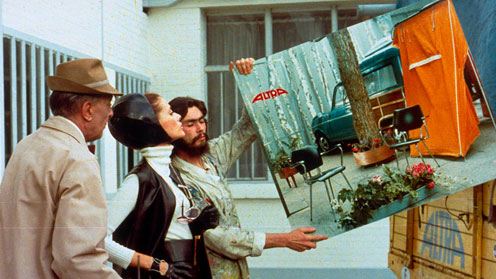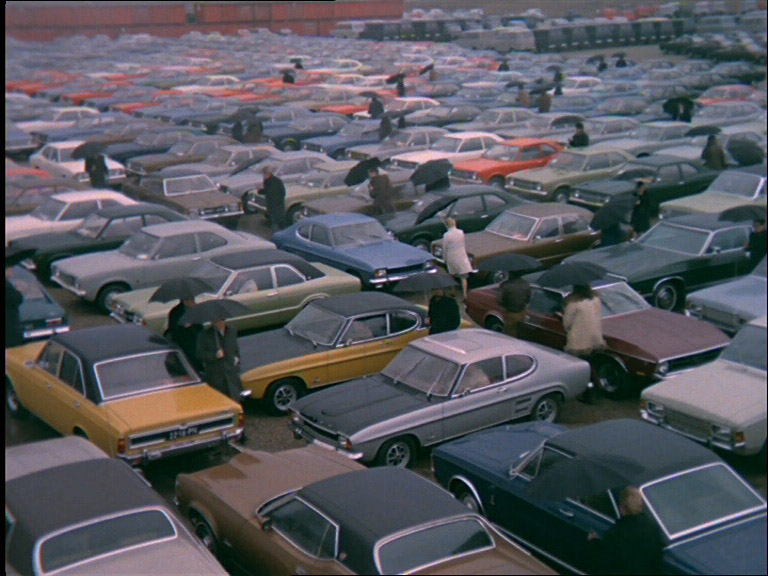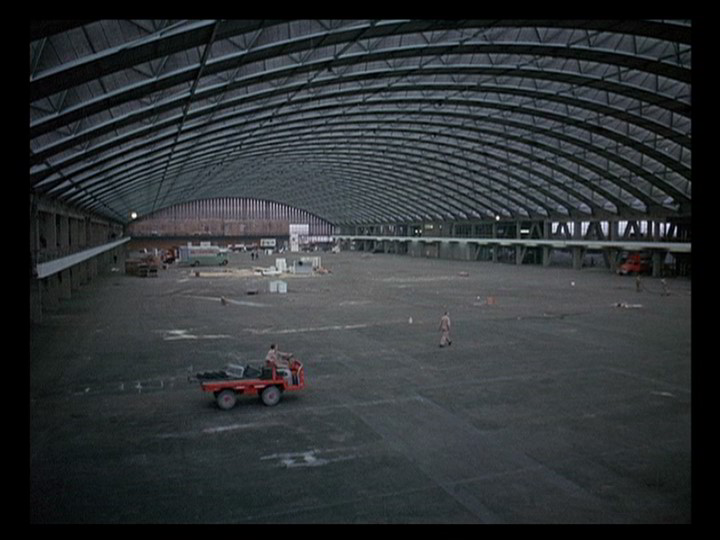This review appeared originally in Fanzine, 6/26/08. –J.R.
Given the size of his achievement, it’s astonishing that Jacques Tati made only half a dozen features, none of them bad. But if I had to single out any of these as a lesser work, I’d pick Trafic (1971), the only one that qualifies as compromised.
Others might select Parade (1973), Tati’s final film –– because it was mainly shot on video and virtually dispenses with plot by basically following the contours of a far-from-spectacular circus performance. But they’d be wrong. Though it’s the least known Tati feature and the most modest in terms of budget, Parade is by no means Tati’s least ambitious or adventurous film. In some ways it even qualifies as his most radical –– in its refusal to clearly separate life from spectacle or prioritize professional performers over unprofessional spectators. Unfortunately, the less analytical and more sentimental celebrations of Tati –– including the charming 1989 documentary by the late Sophie Tatischeff about her father, In the Footsteps of Monsieur Hulot, that’s a bonus on the second disc here –– tend to overlook this radicalism.
Trafic, on the other hand, represented a conscious step backward for Tati. Because, as the opening credits plainly state, the film stars “Mr. Hulot,” this was already contrary to the direction he wanted to move in. He told me that when I interviewed him for Film Comment in November 1972. And when I briefly went to work for him the following January, it was obvious that Playtime (1967), his greatest film, was also the one he was proudest of. Not that he repudiated Trafic, but he stressed it was a film he could have made before Playtime. (Anecdotal aside: During this period, long after the French premiere of Trafic, I learned that Tati had recently gone back and added an entire jokey subplot to the available prints –– something he’d also done for a rerelease of the 1953 Les Vacances de Monsieur Hulot during the 1970s, when he inserted a single new gag alluding to Jaws. In this case, the addition was far more elaborate –– the recurring motif of a filling station handing out busts of dignitaries to customers.)
No two Tati features are alike –– and, as Jonathan Romney observes in his thoughtful liner notes, no two Hulots are alike, either. The character was initially supposed to appear in only one feature, Tati’s second (after his 1949 Jour de fête), and was brought back reluctantly in Mon oncle (1958) because of public demand; this time Tati gave him a visible home and suburban relatives, took away his rattling car, and suggested he was unemployable, even if he had a benign influence on his nephew. (Meanwhile, Mr. Hulot’s Holiday was a bigger commercial smash than Jour de fête, and Mon oncle was still bigger, winning Tati his only Oscar.) Then, after the demand for Hulot continued unabated, he tried multiplying this character in Playtime, still apparently unemployed, into a series of look-alikes, trying to convey the notion that it was everyone, not this single dopey-looking guy, who was supposed to be funny. He even made sure that Hulot’s parting gift to the heroine, a bouquet of plastic flowers, was delivered by one of his younger doubles while Hulot himself was about to dissolve into a street crowd. But after Playtime tanked and drove Tati into bankruptcy, to finance another feature he was forced to bring back Hulot and make him more prominent again. So Tati made him the designer of a rather ridiculous camper that he and others try in vain to transport from Paris to an Amsterdam auto show. In short, his bankability as an actor –– more specifically, as one of his roles as an actor –– had to supersede his ambitions as a director.
Which may account for why Trafic is the only Tati film with any traces of anger. Many of the bad vibes cluster around Maria (Maria Kimberley), an ill-mannered p.r. rep and posturing fashion plate who personifies the rush leading to multiple mishaps and one rather spectacular auto accident. The fact that Maria typically makes sharp right-angle turns when she walks already marks her as a villainess, at least according to the geometrical ethics of Playtime, where lackadaisical, accidental curves are signs of humanity triumphing over architectural regimentation. A somewhat more sympathetic view of her finally emerges by the end, after she accidentally spills ink on her glasses in the Dutch rural garage –– and when she becomes Hulot’s escort in the rain in the final sequence, culminating in the bittersweet melancholy of the final shot, which seems to view humanity itself as a bemused tribe lost in a senseless labyrinth.
Harking back to the bucolic pleasures that were prominent in Tati’s first two features, Trafic posits aimless and haphazard drift as a meaningful alternative to capitalist compulsiveness. This helps to explain why documentary (including much of the footage of motorists Tati took over from his initial codirector, Bert Haanstra) becomes a part of his artistic palette here, at the same time that hippies are welcomed into his social universe. Both become even more prominent in Parade.
Critic Michel Chion writes that Trafic recounts “a journey between two places, neither of which really exists,” adding that “Paris is a motorway exit and a corner of a square fleetingly glimpsed; Amsterdam is reduced to an exhibition hall. Only the journey is real.” To which one might add that the only place in Trafic that feels very real is a Dutch garage beside a canal where nothing much happens (apart from some casual repair work, and a rather malicious if well-developed gag about a hippie coat made to resemble Maria’s equally fluffy dog).
If the weakest portions of Playtime are the demonstrations of absurd gadgets at a trade show, the parallel weak spots here appear not at the Amsterdam auto exhibition –– where Tati can indulge in such formal delights as the rhythmic games he plays with the opening and closing of various trunks and hoods –– but at the police office in Holland, where the absurd fixtures of the camper are duly (and dully) trotted out for the customs inspectors and us. But alongside the canal, there are a few privileged moments when plotlines are forgotten, time seems to stop, and the improvisations that grow out of casual observations begin. This is also the stretch when Maria spills ink on her sunglasses. Trafic might be said to take an easy breath here, and so do we.





